Sint Eustatius
This articleneeds additional citations forverification.(July 2022) |
Sint Eustatius | |
|---|---|
| Motto(s): | |
| Anthem:"Golden Rock" | |
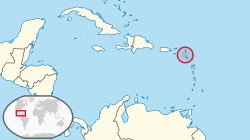 Location of Sint Eustatius (circled in red) in theCaribbean | |
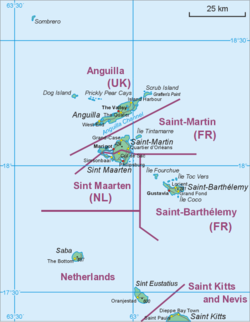 Map showing the location of St. Eustatius relative toSabaandSt. Martin | |
| Coordinates:17°29′N62°59′W/ 17.483°N 62.983°W | |
| Country | |
| Overseas region | Caribbean Netherlands |
| Incorporated into the Netherlands | 10 October 2010 (dissolution of the Netherlands Antilles) |
| Capital (and largest city) | Oranjestad |
| Government | |
| •Lt. Governor | Alida Francis(Government commissioner)[1] |
| Area | |
| • Total | 21 km2(8 sq mi) |
| Population (1 January 2022)[3] | |
| • Total | 3,242 |
| • Density | 154/km2(405/sq mi) |
| Demonym(s) | St. Eustatian; Statian |
| Languages | |
| • Official | English[4]•Dutch |
| Time zone | UTC−4(AST) |
| Calling code | +599-3 |
| ISO 3166 code | BQ-SE,NL-BQ3 |
| Currency | United States dollar($) (USD) |
| Internet TLD | |
Sint Eustatius(/juˈsteɪʃəs/yoo-STAY-shəs,Dutch pronunciation:[sɪntøːˈstaːtsijʏs]),[7]known locally asStatia(/ˈsteɪʃə/STAY-shə),[8]is an island in theCaribbean.It is aspecial municipality(officially "public body") of theNetherlands.[9]
The island is in the northernLeeward Islands,southeast of theVirgin Islands.Sint Eustatius is immediately to the northwest ofSaint Kittsand southeast ofSaba.The regional capital isOranjestad.The island has an area of 21 square kilometres (8.1 sq mi).[2]Travelers to the island by air arrive throughF. D. Roosevelt Airport.
Formerly part of theNetherlands Antilles,Sint Eustatiusbecame a public bodyof the Netherlands in 2010.[10]It is part of theDutch Caribbean,which consists ofAruba,Bonaire,Curaçao,Saba,Sint Eustatius, andSint Maarten.Together with Bonaire and Saba, it forms the BES Islands, also referred to as theCaribbean Netherlands.[11]
Etymology[edit]
The island's name, Sint Eustatius, is Dutch forSaint Eustace(also spelled Eustachius or Eustathius), a legendary Christianmartyr,known in Spanish asSan Eustaquioand in Portuguese asSanto EustáquioorSanto Eustácio.
The island's prior Dutch name wasNieuw Zeeland('New Zeeland'), named by theZeelanderswho settled there in the 1630s.[12][13]It was renamed Sint Eustatius shortly thereafter.[12]
The indigenous name for the island isAloimeaning "cashew island" (originArawak).[14][15]
History[edit]

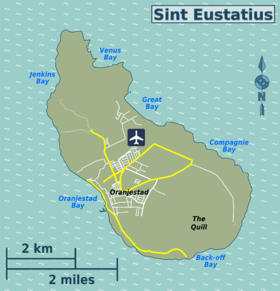
The earliest inhabitants were Caribs[16]believed to have come from theAmazon basin(South America) and migrated north fromVenezuela[16]via theLesser Antilles.[16]In the early 20th century, settlement traces were discovered at Golden Rock and Orange Bay. Multiple pre-Columbian sites have been found on the island, most notably the site referred to as the "Golden Rock Site".[17]
While the island may have been seen byChristopher Columbusin 1493,[18]the first recorded sighting was in 1595 bySir Francis DrakeandSir John Hawkins.[18][19]From the first European settlement in the 17th century, until the early 19th century, St. Eustatius changed hands twenty-one times between the Netherlands, Britain, and France.[18][20]
In 1625, English and French settlers arrived on the island.[21][22]In 1629, the French built a wooden battery at the present-day location ofFort Oranje.[23]Both the English and the French left the island within a few years due to lack of drinkable water.[24][25]
In 1636, the chamber of Zeeland of theDutch West India Companytook possession of the island,[26][22]reported to be uninhabited at the time.[27][28]In 1678 the islands of St. Eustatius, Sint Maarten and Saba were under the direct command of the Dutch West India Company, with a commander stationed on St. Eustatius to govern all three.[citation needed]At the time, the island was of some importance for the cultivation oftobaccoandsugar.[29]More important was the role of St. Eustatius in thetrans-Atlantic slave tradeand the intercolonial slave trade.[18][30]
Slave trade and free port[edit]

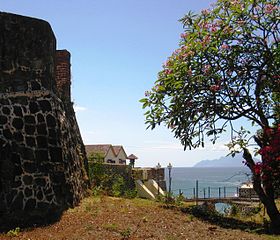
Sint Eustatius became the most profitable asset of the Dutch West India Company[citation needed]and a transit point for enslaved Africans in thetransatlantic slave trade.[29][31]The ruins of theWaterforton the southwest coast of the island are reminders of this past. A slave house of two floors was in the Waterfort. Plantations of sugarcane, cotton, tobacco, coffee and indigo were established on the island and worked with labor of enslaved Africans.[31]In 1774 there were 75plantations on the island[citation needed]with names such as Gilboa, Kuilzak, Zelandia, Zorg en Rust, Nooit Gedacht, Ruym Sigt and Golden Rock.
In the 18th century, St. Eustatius's geographical placement in the middle of Danish (Virgin Islands), British (Jamaica,St. Kitts,Barbados,Antigua), French (St. Domingue,Ste. Lucie,Martinique,Guadeloupe) and Spanish (Cuba,Santo Domingo,Puerto Rico) territories—along with its large harborage,neutralityand status from 1756[32]as afree portwith nocustomsduties—were all factors in it becoming a major point of transhipment of captured Africans, goods, and a locus for trade incontraband.[32][33]Transshipment of captured Africans to the British, French, and Spanish islands of the eastern Caribbean was significant enough that the colonists built a two-story slave house at thefortress Amsterdam(also known as Waterfort) to serve as a depot of enslaved Africans until around 1740.[34]The depot housed about 400-450 people.[35]St. Eustatius's economy flourished under the Dutch by ignoring the monopolistic trade restrictions of the British, French and Spanish islands[citation needed];it became known as the "Golden Rock".[36][37][38]Edmund Burkesaid of the island in 1781:
It has no produce, no fortifications for its defence, nor martial spirit nor military regulations... Its utility was its defence. The universality of its use, the neutrality of its nature was its security and its safeguard. Its proprietors had, in the spirit of commerce, made it an emporium for all the world.... Its wealth was prodigious, arising from its industry and the nature of its commerce.[8]
"First Salute"[edit]

The island soldarmsandammunitionto anyone willing to pay, and it was therefore one of the few places from which the young United States could obtain military stores. The good relationship between St. Eustatius and the United States resulted in the noted "First Salute".
On November 16 1776, the 14-gun American brigAndrew Doriacommanded by CaptainIsaiah Robinson[39][40]sailed, flying theContinental Colorsof the fledgling United States, into the anchorage below St. Eustatius's Fort Oranje. Robinson announced his arrival by firing a thirteen gun salute, one gun for each of the thirteen American colonies in rebellion against Britain. GovernorJohannes de Graaffreplied with an eleven-gun salute from the cannons of Fort Oranje (international protocol required two guns fewer to acknowledge a sovereign flag). It was the first international acknowledgment of American independence.[Note 1]TheAndrew Doriahad arrived to purchase munitions for the American Revolutionary forces. She was carrying a copy of the Declaration of Independence which was presented to Governor De Graaff. An earlier copy had been captured by the British on its way to Holland. It was wrapped in documents that the British believed to be a strange cipher, but were actually written inYiddish,addressed to Jewish merchants in Holland.

PresidentFranklin D. Rooseveltvisited St. Eustatius for two hours on 27 February 1939 onUSSHoustonto recognise the importance of the 1776 "First Salute". He presented a large brass plaque to St. Eustatius, displayed today under a flagpole atop the walls of Fort Oranje, reading:
In commemoration to the salute to the flag of the United States, Fired in this fort November 16. 1776, By order of Johannes de Graaff, Governor of Saint Eustatius, In reply to a National Gun-Salute, Fired by the United States Brig of War Andrew Doria, Under Captain Isaiah Robinson of the Continental Navy, Here the sovereignty of the United States of America was first formally acknowledged to a national vessel by a foreign official. Presented by Franklin Delano Roosevelt, President of the United States of America
The recognition provided the title forBarbara W. Tuchman's 1988 bookThe First Salute: A View of theAmerican Revolution.
Capture by British Admiral Rodney 1781[edit]
The British took the Andrew Doria incident seriously, and protested bitterly against the continuous trade between the United Colonies and St. Eustatius. In 1778,Lord Stormontclaimed inParliamentthat, "if Sint Eustatius had sunk into the sea three years before, the United Kingdom would already have dealt withGeorge Washington".Nearly half of all American Revolutionary military supplies were obtained through St. Eustatius. Nearly all American communications to Europe first passed through the island. The trade between St. Eustatius and the United States was the main reason for theFourth Anglo-Dutch Warof 1780–1784.[40]Notably, the British Admiral George Brydges Rodney, having occupied the island for Great Britain in 1781, urged the commander of the landing troops, Major-General Sir John Vaughan, to seize "Mr. Smith at the house of Jones – they (the Jews of St. Eustatius, Caribbean Antilles)[41]cannot be too soon taken care of – they are notorious in the cause of America and France. "The war was disastrous for the Dutch economy.

Britain declared war on the Republic of the Seven United Netherlands on 20 December 1780. Even before officially declaring war, Britain had outfitted a massive battle fleet to take and destroy the weapons depot and vital commercial centre that St. Eustatius had become. British AdmiralGeorge Brydges Rodneywas appointed the commander of the battle fleet. 3 February 1781, the massive fleet of 15 ships of the line and numerous smaller ships transporting over 3,000 soldiers appeared before St. Eustatius prepared to invade. Governor De Graaff did not know about thedeclaration of war.Rodney offered De Graaff a bloodless surrender to his superior force. Rodney had more than 1,000 cannon to De Graaff's one dozen cannon and a garrison of sixty men. De Graaff surrendered the island, but first fired two rounds as a show of resistance in honour of Dutch AdmiralLodewijk van Bylandt,who commanded a ship of the Dutch Navy which was in the harbor.[8]Ten months later, the island was conquered by the French, allies of theDutch Republicin the war. The Dutch regained control over the looted and plundered island in 1784.
A series of disastrous French and British occupations of Sint Eustatius from 1795 to 1815 diverted trade to the occupiers' islands. St. Eustatius's economy collapsed, and the merchants, including the Jews left. St. Eustatius reverted permanently to Dutch control from 1816.
At its peak, St. Eustatius may have had a largely transient population of about 10,000 people. Most were engaged in commercial and maritime interests. A census list of 1790 gives a total population (free and enslaved people combined) of 8,124. Commerce revived after the British left. Many of the merchants (including the Jews) returned to the island. However, French and British occupations from 1795 disrupted trade and also the North-Americans, now globally recognised as an independent nation, had meanwhile developed their own trading network and did not need St. Eustatius anymore. The island was eclipsed by other Dutch ports, such as those on the islands ofCuraçaoandSint Maarten.During the last years of the 18th century Statia developed trade in bay rum. The economy declined in the early 19th century. From about 1795 the population declined, dropping to 921 in 1948.
Jewish population[edit]
The first record of Jews on St. Eustatius dates to 1660. The Jews were mainly merchants with significant international trading and maritime commercial ties. Jews were captains, owners or co-owners with Christian partners, of significant numbers of ships originating out of St. Eustatius. A few were island plantation owners. Jews were estimated[by whom?]to have composed at least 10% of the permanent population of St. Eustatius.[42]
Ten days after the island surrendered to the British on 3 February 1781, Rodney ordered that the entire Jewish male adult population assemble for him. They were rounded up and thirty one heads of families were summarily deported to St. Kitts without word or mercy to their dependents. The choice of exiling the Jews to St. Kitts was significant. The nearby British Island ofNevishad a large Jewish population and an established community capable of aiding the refugees. St. Kitts did not have any Jewish community or population. The other seventy-one were locked up in the weighing house in Lower Town where they were held for three days.
Expulsion of Americans followed on 23 February, of merchants from Amsterdam on 24 February and of other Dutch citizens and Frenchmen on 5 March. The crews of the Dutch ships Rodney took were sent to St. Kitts for imprisonment – after first stripping them of all their belongings. Because of their maltreatment, many perished. The Jews were well received on St. Kitts – where many knew them as their respected business partners. They were supported in their protest against their deportation and it proved successful. They were allowed to return to St. Eustatius after a few weeks to observe all their property being sold at small fractions of the original value after having been confiscated by Rodney.
The resentment the British felt for the population of this island that helped the Americans to defeat them translated in a harsh treatment of the inhabitants. There were numerous complaints about "individuals of both sexes being halted in the streets and being body searched in a most scandalous way."[43]Pieter Runnels, an eighty-year-old member of the island council and captain of the civic guard, did not survive the rough treatment he received aboard Rodney's ship. He, a member of one of the island's oldest-established families, became the only civilian casualty of the British occupation. British soldiers prevented the family and others paying their last respects at his funeral from using the water from the family's own cistern.
The tomb of former governor Jan de Windt was broken open by British soldiers, all the silver decorations stolen off the caskets, and the bodies of the governor and his wife exposed, without any of Rodney's officers interfering.
Rodney singled out the Jews: the harshness was reserved for them alone. He did not do the same to French, Dutch, Spanish or even the American merchants on the island. He permitted the French to leave with all their possessions. Rodney was concerned that his unprecedented behavior would be repeated upon British islands by French forces when events were different. However, Governor De Graaff was also deported.
As he did with all other warehouses, Rodney confiscated the Jewish warehouses, looted Jewish personal possessions, even cutting the lining of their clothes to find money hidden in there. When Rodney realized that the Jews might be hiding additional treasure, he dug up the Jewish cemetery.[44]
Later, in February 1782,Edmund Burke,the leading opposition member of the Whig Party, upon learning of Rodney's actions in St. Eustatius, rose to condemn Rodney's anti-Semitic, avaricious vindictiveness inParliament:
...and a sentence of general beggary pronounced in one moment upon a whole people. A cruelty unheard of in Europe for many years… The persecution was begun with the people whom of all others it ought to be the care and the wish of human nations to protect, the Jews… the links of communication, the mercantile chain… the conductors by which credit was transmitted through the world…a resolution taken (by the British conquerors) to banish this unhappy people from the island. They suffered in common with the rest of the inhabitants, the loss of their merchandise, their bills, their houses, and their provisions; and after this they were ordered to quit the island, and only one day was given them for preparation; they petitioned, they remonstrated against so hard a sentence, but in vain; it was irrevocable. [45]
The synagogue and the cemetery[edit]
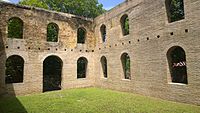
From about 1815, when there was no longer a viable Jewish community using and maintaining the synagogue on St. Eustatius, it gradually fell into ruin.
The synagogue building, known as Honen Dalim, (He who is charitable to the Poor) was built in 1737. Permission for building the synagogue came from the Dutch West India Company, additional funding came from the Jewish community on Curaçao. Permission was conditional on the fact that the Jewish house of worship would be sited where "the exercise of their (Jewish) religious duties would not molest those of the Gentiles".[46]The building is off a small lane called Synagogue Path, away from the main street. The synagogue attested to the wealth of the Jews of St. Eustatius and their influence on the island.[47]

In 2001, its walls were restored as part of theHistoric Core Restoration Project,although there are no known images showing what the synagogue looked like when still in use, so that archeological research is attempting to restore the structure to the best estimate of its former condition. The grounds include a Jewish ritual bath (mikveh) and an oven used onPassover.
A restored and respectfully maintained Jewish cemetery is next to the Old Church Cemetery, at the top of Oranjestad, Sint Eustatius.
Slave Revolt of 1848[edit]
After 1848,slaveryonly existed on the Dutch and Danish Eastern Caribbean islands, which caused unrest on the islands colonized bythe Netherlands.As a result, a proclamation declared on 6 June 1848 on Sint Maarten that enslavedAfricanswould be treated as free persons.[48]
Unrest also arose on Sint Eustatius. On 12 June 1848, a group of free and enslaved Africans gathered in front of Lieutenant Governor Johannes de Veer's home demanding their declaration of liberty, increased rations, and more free hours. The Island Governor addressed the group, but it persisted in its demands. The militia was mobilized and, after consultation with the Colonial Council and the main residents, an attack was decided by the Lieutenant Governor. After another warning to leave the city or otherwise experience the consequences, fire was opened on the group. The insurgents fled the city, leaving two or three seriously injured. From a hill just outside the city they pelted the militia with stones and pieces of rock. A group of 35 shooters stormed the hill, killing two insurgents and injuring several. The six leaders of the uprising were exiled from the island and transferred toCuraçao.Thomas Dupersoy,a free African, is considered the chief leader of the uprising. One of the other leaders sent a death notice to his owner in 1851. After the uprising, the largest plantation owners on Sint Eustatius decided to give their enslaved workers a certain wage for fear of repetition of revolt.[49]
Abolition of slavery[edit]
In 1863 slavery was officially abolished in the Netherlands. The Dutch were among the last to abolish slavery.[50]The freed slaves no longer wanted to live in the field and moved to the city. Due to a lack of trade, the bay of Sint Eustatius underwent a recession. Natural disasters such as the hurricane of September 1928 and May 1929 accelerated the process of economic decline on the island.
Dissolution of the Netherlands Antilles[edit]
Sint Eustatius became a member of theNetherlands Antilleswhen that grouping was created in 1954. Between 2000 and 2005 the member islands of the Netherlands Antilles voted on their future status. In areferendum on 8 April 2005,77% of Sint Eustatius voters voted to remain within the Netherlands Antilles, compared to 21% who voted for closer ties with the Netherlands. None of the other islands voted to remain.
After the other islands decided to leave, ending the Netherlands Antilles, theisland councilopted to become a special municipality of the Netherlands, like Saba and Bonaire. This process was completed in October 2010.[40]In 2011 the island officially adopted theUS dollaras its currency.[51]
Geography[edit]
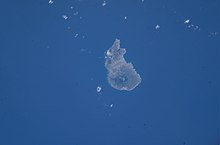
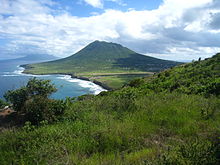
Sint Eustatius is 6 miles (10 km) long and up to 3 miles (5 km) wide.[52]Topographically, the island is saddle-shaped, with the 602-metre (1,975 ft) high dormant volcanoQuill(Mount Mazinga), (from Dutchkuil,meaning 'pit'—originally referring to its crater) to the southeast and the smaller summits of Signal Hill/Little Mountain (orBergje) and Boven Mountain to the northwest. The Quill crater is a populartouristattraction on the island. The bulk of the island's population lives in the flatsaddlebetween the two elevated areas, which forms the centre of the island.[52]
Climate[edit]
St. Eustatius has atropical monsoon climate.Tropical storms and hurricanes are common. The Atlantic hurricane season runs from 1 June to 30 November, sharply peaking from late August through September.Tropical Cyclone Climatology
Nature[edit]

As St. Eustatius is a volcanic island and very small, all of the beaches on the island are made up of black volcanic sand. These volcanic sands, especially one of the more popular nesting beaches called Zeelandia, are very important nesting sites for several endangered sea turtles such as: thegreen turtle,leatherback,loggerheadandhawksbill.[53]
Sint Eustatius is home to one of the last remaining populations of thecritically endangeredLesser Antillean iguana(Iguana delicatissima).[54]The population was strongly affected during the high-intensity hurricane year of 2017, with especiallyHurricane Maria,during which the population declined by 25%.[55]
National parks[edit]
Sint Eustatius has three nature parks – on land and at sea: the Sint Eustatius National Marine Park,Quill/Boven National Park,and Miriam Schmidt Botanical Garden. Two of them have national park status. These areas have been designated as important bird areas. The nature parks are maintained by theSt Eustatius National Parks Foundation(STENAPA).[56]
Archaeology[edit]
Due to its turbulent history, Sint Eustatius is rich in archaeological sites. Nearly 300 sites have been documented.[57]The island is said to have the highest concentration of archaeological sites of any area of comparable size.[58]In the 1920s,J. P. B. de Josselin de Jongconducted archaeological research intoSaladoidsites on the island and in the 1980s a great deal of research at theGolden Rock sitewas done by archaeologist Aad Versteeg ofLeiden University.Around 1981, under the direction of archaeologist Norman F. Barka, theCollege of William & MaryinWilliamsburg, Virginiaalso started archaeological research on Sint Eustatius. The documented archaeological sites include prehistoric sites, plantations, military sites, commercial trading sites (including shipwrecks), and urban sites (churches, government buildings, cemeteries, residences). TheSt. Eustatius Center for Archaeological Research(SECAR) has been conducting archaeological research on the island since 2004[59]including excavations at theGodet African Burial Groundand theGolden Rock African Burial Ground.
In June 2021, SECAR became involved in protests against excavations at the 18th-centuryburial ground Golden Rockon the island. TheUbuntu Connected Frontand other concerned citizens of Sint Eustatius denounced the non-involvement of the community in the excavation process through a petition and letters to the government.[60][61][62]The majority of the population on St. Eustatius are of African descent. Participation in cultural heritage, i.e. involving the community whose ancestors are being excavated, is good practice in contemporary archaeology.[63]Archaeological excavations on St. Eustatius apparently fall under the old Monuments Act for the BES islands[64]that is very brief on these issues. The 2016 Dutch Heritage Act[65]offers more protection for cultural heritage. The Committee on Kingdom Relations askedSecretary of StateRaymond Knopsquestions about the matter.[66]TheStatia Heritage and Research Commission(SHRC) set up by the government of St. Eustatius investigated the allegations of the protest groups and published its report in January 2022.[67][68]
Demography[edit]
Population[edit]
As of January 2022, the population was 3,242,[3]with a population density of 154 inhabitants per square kilometre.

Language[edit]
The official language is Dutch, but English is the "language of everyday life" on the island and education is solely in English.[69]A local English-basedcreoleis also spoken informally. More than 52% of the population speak more than one language. The most widely spoken languages are English (92.7%), Dutch (36%), Spanish (33.8%) andPapiamento(20.8%).
Religion[edit]
The population of Sint Eustatius is predominantlyChristian.The main denominations areMethodism(28.6%),Roman Catholicism(23.7%),Seventh-Day Adventist(17.8%),Pentecostalism(7.2%) andAnglicanism(2.6%).[70]
Religion in Sint Eustatius (2018):[70]

Economy[edit]
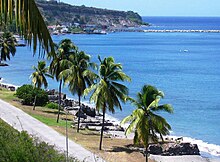
In the 18th century, "Statia" was the most important Dutch island in the Caribbean and was a center of great wealth from trading. At this time it was known as the "Golden Rock" because of its immense wealth. A very large number of warehouses lined the road that runs along Oranje Bay; most (but not all) of these warehouses are now ruined and some of the ruins are partially underwater.
A French occupation in 1795 was the beginning of the end of great prosperity for Sint Eustatius.
According to the Sint Eustatius government website, "Statia's economy is stable and well placed to grow in the near future. With practically no unemployment and a skilled workforce, we have a infrastructure in place to ensure sustained growth."[71]The government itself is the largest employer on the island, and the oil terminal owned byGTI Statiais the largest private employer on the island.[72]
Energy and water[edit]

Statia Utility Company N.V. provides electricity to the island, as well as drinking water per truck and on part of the island by a water network. The electricity supply is rapidly being made green. Until 2016 all electricity was produced by diesel generators. In March 2016 the first phase of the solar park with 1.89MWpcapacity became operational, covering 23% of entire electricity demand. In November 2017[73]another 2.15 MWp was added, totaling 14,345 solar panels, with 4.1 MW capacity and a yearly production of 6.4 GWh. The solar park includes lithium-ion batteries of 5.9 MWh size. These provide power for grid stability, as well as energy shifting. On a sunny day the diesel generators are switched off from 9 a.m. to 8 pm. This is made possible bygrid-forming invertersproduced bySMA.This is one of the first such solar parks in the world and provides 40% to 50% of the island's electricity.
Education[edit]
Dutch government policy towards St. Eustatius and other SSS islands promoted English medium education. Sint Eustatius has bilingual English-Dutch education.[74]
Gwendoline van Putten School(GVP) is a secondary school on the island.
Other schools include: Golden Rock School, Gov. de Graaff School, Methodist School, SDA School.[75]
Sports[edit]
The most popular sports on Sint Eustatius arefootball,[76]futsal,[77][78]softball,[79]basketball,swimmingandvolleyball.Due to the small population, there are few sport associations. One of them, theSint Eustatius Volleyball Association,is a member ofECVAandNORCECA.Currently St. Eustatius is a non-active member of the Caribbean zone ofPony Baseball and Softball leagues.
Famous Statians[edit]
- Antony Beaujon(c.1763–1805), colonial governor
- Gerald Berkel(b. 1969), politician
- Black Harry(18th century), methodist preacher
- Kizzy(b. 1979), artist
- Lolita Euson(1914–1994), writer and poet
- Ziggi Recado(b. 1981), artist
- Shirma Rouse,singer
See also[edit]
- Caribbean Netherlands
- Dissolution of the Netherlands Antilles
- Governors of Sint Eustatius, Saba and Sint Maarten
- F. D. Roosevelt Airport
- Great Hurricane of 1780
- Index of Netherlands Antilles-related articles
- Plantations of Sint Eustatius
Notes[edit]
- ^The first salute to the Colors may have occurred one month earlier. It is debatable if a Colonial merchantman received a formal salute from Fort Frederik on the Danish island of St Croix (The birth of our Flagpage 13 published 1921) and (Americas Library) Translated from the Danish Wikipedia article on Frederiksted "Frederiksted is a town on St Croix in the U.S. Virgin Islands which were previously the Danish West Indies... The town is dominated by the red and white Fort Frederik from the 1750s. The fort has special meaning to both USA and Denmark-Norway. It was from here that the first foreign salute of recognition of USA independence was given in 1776."
References[edit]
- ^"Benoeming regeringscommissaris en plaatsvervanger Sint Eustatius".Rijksoverheid(in Dutch). 18 June 2021.Retrieved19 December2021.
- ^ab"Waaruit bestaat het Koninkrijk der Nederlanden?".Rijksoverheid(in Dutch). 19 May 2015.Retrieved5 April2022.
- ^ab"The Caribbean Netherlands in Numbers 2022".Centraal Bureau voor de Statistiek. 2022. Archived fromthe originalon 6 February 2023.Retrieved2 April2023.
- ^English can be used in relations with the government, see,Invoeringswet openbare lichamen Bonaire, Sint Eustatius en Saba(in Dutch) – via Overheid.nl.
- ^"BQ – Bonaire, Sint Eustatius and Saba".ISO.Archivedfrom the original on 17 June 2016.Retrieved29 August2014.
- ^"Delegation Record for.BQ".IANA.20 December 2010.Archivedfrom the original on 29 May 2012.Retrieved30 December2010.
- ^Mangold, Max.Duden – Das Aussprachewörterbuch.In:Der Duden in zwölf Bänden,Band 6. 7. Auflage. Berlin: Dudenverlag; Mannheim: Institut für Deutsche Sprache, 2015, Seite 786.
- ^abcTuchman, Barbara W. (1988).The First Salute: A View of the American Revolution.New York: Ballantine Books.
- ^Wet openbare lichamen Bonaire, Sint Eustatius en Saba[Law on the public bodies of Bonaire, Sint Eustatius and Saba] (in Dutch) – via Overheid.nl.
- ^"Antillen opgeheven op 10-10-2010".NOS Nieuws(in Dutch). 18 November 2009. Archived fromthe originalon 24 December 2009.Retrieved10 October2010.
- ^Zaken, Ministerie van Algemene (19 May 2015)."Waaruit bestaat het Koninkrijk der Nederlanden? - Rijksoverheid.nl".rijksoverheid.nl(in Dutch).Retrieved28 March2023.[permanent dead link]
- ^abAttema, Y. (1976).St. Eustatius: A Short History of the Island and Its Monuments.Walburg Pers. p. 11.ISBN978-90-6011-153-6.
- ^De Gids. Nieuwe vaderlandsche letteroefeningen(in Dutch). Amsterdam: Stichting de Gids. 1905. p. 299.
{{cite book}}:CS1 maint: date and year (link) - ^Hartog, Johannes (1976).History of St. Eustatius.Central U.S.A. Bicentennial Committee of the Netherlands Antilles: distributors, De Witt Stores N.V.
- ^"Archaeological Excavations at Old Gin House: Remains of a mid-18th to late 18th century domesticate area on a terrace in Lower Town, St. Eustatius, Dutch Caribbean."(2013). The St. Eustatius Center for Archaeological Research.
- ^abcJoh. Hartog,De Bovenwindse eilanden Sint Maarten - saba - Sint Eustatius.De Wit N.N. Aruba (1964), pp. 1-3.
- ^Haviser, Jay B. Jr. (1981).An Inventory of Prehistoric Sites on St. Eustatius, Netherlands Antilles(PDF).Retrieved19 November2021.
- ^abcd"About St. Eustatius: History".Statia Government.16 June 2020.Retrieved28 March2023.
- ^Hartog, Johannes (1978).St. Maarten, Saba, St. Eustatius.De Wit Stores. p. 13.
- ^"Netherlands Antilles".US Department of State.Archived from the original on 15 April 2023.Retrieved15 April2023.
{{cite web}}:CS1 maint: bot: original URL status unknown (link) - ^Westergaard, Waldemar (1917).The Danish West Indies Under Company Rule (1671-1754): With a Supplementary Chapter, 1755-1917.Macmillan. p. 12.
- ^abAspinall, Sir Algernon Edward (1927)."St. Eustatius & Saba".The Pocket Guide to the West Indies, British Guiana, British Honduras, Bermuda, the Spanish Main, Surinam, and the Panama Canal.Sifton, Praed & Company, Limited. p. 343.
- ^Klingelhofer, Eric (11 November 2010)."French Fortifications in the New World".First Forts: Essays on the Archaeology of Proto-colonial Fortifications.BRILL. p. 61.ISBN978-90-04-18732-0.
- ^Aceto, Michael (10 December 2008)."Eastern Caribbean English-derived language varieties: Phonology".In Schneider, Edgar W. (ed.).The Americas and the Caribbean.Walter de Gruyter.ISBN978-3-11-020840-5.
- ^Panton, Kenneth J. (7 May 2015).Historical Dictionary of the British Empire.Rowman & Littlefield. p. 452.ISBN978-0-8108-7524-1.
- ^Hartog, Johannes (1976).History of St. Eustatius.Central U.S.A. Bicentennial Committee of the Netherlands Antilles: distributors, De Witt Stores N.V. p. 21.
- ^Attema, Y. (1976).St. Eustatius: A Short History of the Island and Its Monuments.Walburg Pers. p. 16.ISBN978-90-6011-153-6.
- ^Klooster, Wim (19 October 2016).The Dutch Moment: War, Trade, and Settlement in the Seventeenth-Century Atlantic World.Cornell University Press. p. 16.ISBN978-1-5017-0667-7.
- ^abEmmer, Pieter C.; Gommans, Jos J. L. (15 October 2020).The Dutch Overseas Empire, 1600–1800.Cambridge University Press. pp. 175–179.ISBN978-1-108-42837-8.
- ^Inikori, Joseph E.; Engerman, Stanley L. (30 April 1992).The Atlantic Slave Trade: Effects on Economies, Societies and Peoples in Africa, the Americas, and Europe.Duke University Press. pp. 292–295.ISBN978-0-8223-1243-7.
- ^abMcGreevy, Nora (2 June 2021)."Remains of Enslaved People Found at Site of 18th-Century Caribbean Plantation".Smithsonian Magazine.Retrieved15 April2023.
- ^abTuchman, Barbara W. (1988).The First Salute: A View of the American Revolution.New York: Ballantine Books.
- ^"St Eustatius".Encyclopaedia Britannica.Retrieved28 June2019.
- ^Gregory E. O'Malley and Alex Borucki,"Patterns in the intercolonial slave trade across the Americas before the nineteenth century,"Tempo, 23 (May/Aug 2017): 315-338.
- ^ENTHOVEN, VICTOR (2012).""That Abominable Nest of Pirates": St. Eustatius and the North Americans, 1680—1780 ".Early American Studies.10(2): 239–301.ISSN1543-4273.JSTOR23547669.
- ^"Discover the" Golden Rock ": an island teeming with history".Statia Tourism.Retrieved16 April2023.
- ^Oostindie, Gert; Roitman, Jessica V. (20 June 2014).Dutch Atlantic Connections, 1680-1800: Linking Empires, Bridging Borders.BRILL. p. 135.ISBN978-90-04-27131-9.
- ^Emmer, Pieter C.; Gommans, Jos J. L. (15 October 2020).The Dutch Overseas Empire, 1600–1800.Cambridge University Press. p. 177.ISBN978-1-108-67994-7.
- ^"[Home page]".Andrew Doria – The First Salute, Inc.Archived fromthe originalon 16 December 2014.Retrieved3 October2014.
- ^abc"St Eustatius".Encyclopaedia Britannica.Retrieved28 June2019.
- ^"Jews in British America".The American Revolution.Retrieved4 April2022.
- ^"Prehistoric Period (c. 1300 BC – AD 1492)".St. Eustatius Center for Archaeological Research.Retrieved2 July2020.Source covers growing Jewish population, but gives no numbers.
- ^West Indisch Plakaatboek.Amsterdam. 1979.
{{cite book}}:CS1 maint: location missing publisher (link) - ^Norton, Louis Arthur (October 2006)."Retribution: Admiral Rodney and the Jews of St. Eustatius".Jewish Magazine.Retrieved4 April2022.N
- ^Abbattista, Guido (2008). "Edmund Burke, the Atlantic American War and the 'Poor Jews at St. Eustatius': Empire and the Law of Nations".Cromohs.13:1–39.
- ^Arbell, Mordehai (2002).The Jewish Nation of the Caribbean: The Spanish-Portuguese Jewish Settlements in the Caribbean and the Guianas.Jerusalem: Geffen.
- ^"Honen Dalim Synagogue Restoration Project".St. Eustius Historical Foundation.Archived fromthe originalon 23 February 2015.Retrieved3 October2014.
- ^Paula, A. F. (1993).'Vrije' slaven: Een sociaal-historische studie over de dualistische slavenemancipatie op Nederlands Sint Maarten, 1816–1863.Centraal Historisch Archief, Universiteit van de Nederlandse Antillen. p. 98.ISBN90-6011-841-3.
- ^Hartog, Joh. (1969).De Bovenwindse eilanden: Sint Maarten, Saba, Sint Eustatius(in Dutch). Aruba: De Wit N. V. pp. 296–297.
- ^1863 Abolition of slavery – Timeline Dutch History – Rijksstudio
- ^"Introduction of the Dollar on Bonaire, Saint Eustace, Saba".Government of the Netherlands.18 May 2010. Archived fromthe originalon 26 June 2019.Retrieved26 June2019.
- ^ab"St Eustatius".Encyclopaedia Britannica.Retrieved28 June2019.
- ^"Zeelandia Bay".Lonely Planet.Retrieved4 April2022.
- ^van den Burg, Matthijs P; Meirmans, Patrick G; van Wagensveld, Timothy P; Kluskens, Bart; Madden, Hannah; Welch, Mark E; Breeuwer, Johannes A J (19 February 2018)."The Lesser Antillean Iguana (Iguana delicatissima) on St. Eustatius: Genetically Depauperate and Threatened by Ongoing Hybridization".Journal of Heredity.109(4): 426–437.doi:10.1093/jhered/esy008.eISSN1465-7333.ISSN0022-1503.PMID29471487.
- ^van den Burg, Matthijs P.; Madden, Hannah; van Wagensveld, Timothy P.; Boman, Erik (21 March 2022)."Hurricane-associated population decrease in a critically endangered long-lived reptile"(PDF).Biotropica.54(3): 708–720.doi:10.1111/btp.13087.eISSN1744-7429.ISSN0006-3606.S2CID247602866.
- ^"About Us".St. Eustatius National Parks.Retrieved4 April2022.
- ^Eastman, John (1996).An Archaeological Assessment of St Eustatius, Netherlands Antilles(MA thesis). College of William and Mary.doi:10.21220/s2-aq12-3j05.
- ^"Underwater Archaeology on St. Eustatius – The Caribbean's Historic Gem".The Shipwreck Survey.Archived fromthe originalon 9 April 2022.Retrieved4 April2022.
- ^"About Us".St. Eustatius Center for Archaeological Research.Retrieved4 April2022.
- ^Ubuntu Connected Front (17 June 2021).""Let Our Enslaved Ancestors Rest" – Says UCF Caribbean Chair "(PDF)(Press release). Ubuntu Connected Front.
- ^"Statia Suspends Archaeological Dig at the Airport".St. Eustatius.14 July 2021.Retrieved4 April2022.
- ^Meijer, J. H. T. (9 October 2021).[Letter from J.H.T. (Jan) Meijer](PDF)– via Caraïbisch Uitzicht.
- ^"Faro – Participation in Cultural Heritage –".Cultural Heritage Agency.3 July 2019.Retrieved4 April2022.
- ^Monumentenwet BES(in Dutch) – via Overheid.nl.
- ^Heritage Acthttps://english.inspectie-oe.nl/publications/publication/2016/9/14/[permanent dead link]
- ^"Reactie op verzoek commissie over de stand van zaken voortgang opgravingen vliegveld Sint Eustatius".Tweede Kamer der Staten-Generaal(in Dutch).Retrieved4 April2022.[permanent dead link]
- ^"Statia Heritage Research Commission Officially Installed".St. Eustatius.22 September 2021.Retrieved4 April2022.
- ^"Report of the Statia Heritage Research Commission (SHRC) for the Government of St. Eustatius, Netherlands Caribbean".St. Eustatius Government.28 January 2022.Retrieved29 August2023.
- ^"English to Be Sole Language of Instruction in St Eustatian Schools".Government of the Netherlands.19 June 2014. Archived fromthe originalon 24 February 2015.Retrieved20 February2015.
- ^abStatistics Netherlands (2018).Trends in the Caribbean Netherlands 2018(PDF).The Hague: Statistics Netherlands. p. 80.ISBN978-90-357-2238-5.
- ^"Economy".St. Eustatius Government.Archived fromthe originalon 17 May 2013.Retrieved15 December2012.
- ^"St. Eustatius".Rijksdienst Caribisch Nederland.Archived fromthe originalon 6 October 2014.Retrieved22 April2014.
- ^Bouma, Joop (3 November 2017)."Sint-Eustatius haalt nu al de helft van de stroombehoefte uit zon".Trouw(in Dutch).Retrieved4 April2022.
- ^Dijkhoff, Marta, Silvia Kowenberg, and Paul Tjon Sie Fat. Chapter 215 "The Dutch-speaking Caribbean Die niederländischsprachige Karibik." In:Sociolinguistics / Soziolinguistik.Walter de Gruyter,1 January 2006.ISBN3110199874,9783110199871. Start: p.2105.CITED: p.2108.
- ^"Education".St. Eustatius.16 June 2020.Retrieved4 April2022.
- ^Stokkermans, Karel (29 June 2012)."Sint Eustatius – Football History".Rec.Sport.Soccer Statistics Foundation.RSSSF.Retrieved29 June2012.
- ^"Cruyff Courts Sint Maarten / Sint Eustatius / Saba".Windward Roads.Retrieved4 April2022.
- ^"1st Cruyff Court Dutch Caribbean Futsal Championship 2007 (Aruba)".RSSSF.6 February 2008.Retrieved5 April2022.
- ^"Saba and St. Eustatius Compete in Softball".Pearl FM Radio – Pearl of the Caribbean.27 June 2011.Retrieved5 April2022.
Bibliography[edit]
- Arbell, Mordechai (2002).The Jewish Nation of the Caribbean, The Spanish-Portuguese Jewish Settlements in the Caribbean and the Guianas.Jerusalem: Geffen Press.ISBN978-9652292797.
- Attema, Y (1976).A Short History of St. Eustatius and its Monuments.Zutphen: Walburg Pers.ISBN978-9060111536.
- Bernardini, P; Fierling, N, eds. (2001).The Jews and the Expansion of Europe to the West, 1450–1800.New York: Berghahn Books.ISBN978-1571811530.
- Ezratty, Harry (2002) [1997].500 Years in the Jewish Caribbean – The Spanish and Portuguese Jews in the West Indies.Baltimore, MD: Omni Arts.ISBN978-0942929188.
- Hartog, J (1976).History of St. Eustatius.Central USA Bicentennial Committee of the Netherlands Antilles.
- Hearst, Ronald (1996).The Golden Rock.Annapolis, MD: Naval Institute Press.
- Morse, Jedidiah(1797)."St. Eustatius".The American Gazetteer.Boston, MA: At the presses of S. Hall, and Thomas & Andrews.OL23272543M.
- Spinney, David (1969).Rodney.London: Allen & Unwin.ISBN978-0049200227.
- O'Shaughessy, Andrew Jackson (2013).The men who lost America: British Command during the Revolutionary War and the Preservation of the Empire.New Haven, CT: Yale University Press.ISBN978-1-78074-246-5.
- Tuchman, Babara W (1988).The First Salute.Westminster, MD: Alfred A. Knopf.ISBN978-0394553337.
External links[edit]
- St. Eustatius Government
- St. Eustatius Tourist Office's homepage
- The website of STENAPA, the National Parks of St. Eustatius
- St. Eustatius info in Lonely Planet website
- St. Eustatius Center for Archaeological Research
- The Farm in St. Eustatius: Not Dead Yet[permanent dead link]
- Colorful stories from St. Eustatius's eventful history. Saba invasion
- Colorful stories from St. Eustatius's eventful history. Bermuda connection
- "Retribution: Admiral Rodney and the Jews of St. Eustatius",by Louis Arthur Norton



